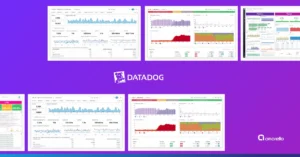Years ago the term Shadow IT became the nightmare of systems departments, representing a security breach for companies, as it compromised the privacy and reliability of data, and even the optimal functioning of authorized systems. In the digital era this threat has re-emerged as Shadow AI. But what does this term mean and why should we be concerned?
2023 is a year that will be marked by the massive adoption of AI. A large number of companies expressed their intentions to incorporate this tool in their processes, and a significant number of them started with the implementation process. But beyond this, people are adopting generative AI tools in their day-to-day lives, both for recreation and to streamline their work performance.
Check out: Science, Data, Cloud and Rock & Roll.
The fast-paced digital transformation process is one that experiences continuous acceleration peaks that challenge the ability of companies to adapt their security protocols accordingly. The lack of formal regulations, as well as the integration and implementation of AI tools that lack corporate use certification, represent a latent threat that needs to be addressed seriously and proactively.
The Rise of the Dark Side
Artificial Intelligence is transforming the business world with multiple benefits that promise a bright future for business productivity, but its excessive growth brings with it multiple risks that feed its dark side, one of them is Shadow AI, a threat that can corrupt information, outwit defenses and destroy trust, putting the future of your company at risk.
In the 1970s, security was a relatively simple issue. Technology management was centralized in the IT departments of companies, where access was controlled and security measures were implemented; however, this centralization limited the flexibility and agility of companies.
.png)
Just 10 years later, the advent of personal computers revolutionized the landscape. Users, without the need for technical knowledge, could acquire their own equipment and implement tools for their specific needs, and while this represented greater autonomy and productivity, it also introduced new security risks.
The tools used were not always compatible with the companies’ central systems, coupled with a lack of synchronization when saving changes to shared data, creating gaps in the exchange and management of information. In addition, the lack of centralized control over security also exposed companies to intrusions and malware.
Related reading: Artificial Intelligence: the new threat to the Cloud?
In this context, the term “Shadow IT” was born, which refers to a set of computer systems and tools that operate outside the control of a company’s IT department. While Shadow IT could offer fast and flexible solutions, it also represented and still represents a significant security breach.
With the explosion of AI and the unplanned adoption of unsuspecting of generative tools by users to consult, or learn about issues, concerns and even solve problems of interest to them, history seems to be repeating itself.
Shadow AI, is the term that describes the unauthorized use of artificial intelligence in creative and productive ways within an organization, without following proper oversight protocol, resulting in vulnerabilities in security and data governance.
Shadow AI Awakening
Shadow AI is spreading by stealth, infiltrating companies in multiple ways. From phishing phishing emails emails to the creation of deepfakes almost indistinguishable, the dangers of this new threat are unleashing a new era of terror for CISOs (Chief Information Security Officers).
It’s not just about stealing identities or damaging brand reputation. Shadow AI attack vectors are much more sophisticated, including smarter ways to infiltrate code and disguise themselves as legitimate software or files to access and expose sensitive proprietary data, such as trade secrets or financial information.
And the consequences of their onslaught can be devastating. The loss of confidential data can result in millions of dollars in fines, reputational damage and, ultimately, the loss of customer and partner trust.
.png)
Articles of interest: The Power of Marketing in the Data Driven Era.
The worst part and even more alarming is that most of these leaks may go unnoticed until it is too late, as most users run non-corporate generative AI to complete their work activities without being aware of the risks involved.
No wonder giants such as Apple, JPMorgan Chase, Deutsche Bank, Samsung and Amazon have banned their employees from using ChatGPT. The shadow of risk hangs over this tool, especially after the leak of confidential information by Samsung employees and the recent flaw that allowed users to observe other people’s conversations.
Deciphering the mysteries of the Menace: Why is Shadow AI so dangerous?
Previously reserved for data scientists and similar profiles, ML and AI have been democratized with the use of natural language, now being integrated into a variety of business areas, from imaging and copy creation to code development. However, this widespread use lacks guidelines, and according to a Salesforce survey, 52% of respondents report an increase in the use of generative AI.
According to the same study, 49% of people have used Generative AI, and more than a third use it on a daily basis. According to The Conference Board, 56% of employees in U.S. organizations use Generative AI, but only 26% of companies have a formal Generative AI policy, and another 23% are developing one.
Unlike Shadow IT, whose risks of data leakage or malware can be mitigated to some extent by checking physical devices such as laptops, smartphones and USB drives, Shadow AI operates on an intangible plane: the code. As these are artificial intelligence tools that are used without the knowledge or oversight of the IT department.
This makes it much more difficult to detect and control. In addition, Shadow AI is highly malleable, allowing it to be deployed for malicious purposes, such as creating bots that automate tasks, analyzing data to make biased decisions, or generating fake content.
The hazards identified include:
- Uncontrolled applications
Natural language support has allowed virtually anyone to rely on generative AI for the development of apps capable of running within the enterprise, but lacking a specialized domain and without a protocol for supervised use this can result in the infiltration of undetected malicious code. - Information leakage
Generative AI learns from the queries we make, absorbing information from companies, people, processes and systems, among other points; generally leaking this information to the outside. This can turn seemingly harmless uses such as creating marketing content into a risk of exposing sensitive information such as marketing strategies or financial information such as budgets to the world.Dive into: Machine Learning: Future and mainstay of online stores?
As a side note, broadly related to this point, the learning and adaptability of AI makes it more dangerous, as it learns from the actions of users and security measures, traditional defenses can fall short. This means that companies and organizations must constantly adapt their security measures to stay ahead of the curve.
- Biases and/or discrimination of information
The correct performance of a generative AI depends on correct training. Limited or restricted data can lead to unwanted biases and erroneous results. When working in the shadows, AI information sources are generally restricted to specific subsets of the company or to very particular criteria, causing undesired discrimination, precisely because of having limited sources of data for decision making..png)
- Hallucinations
Hallucinations are one of the most prominent risks in the GenAI world, present even beyond the clandestine realm. Vectara, a start-up founded by former Google employees, claims that generative AI chatbots invent details in at least 3% of interactions, a figure that can go as high as 27%.In the context of shadow AI, this problem is exacerbated for the following reasons:
Unverified parameters and ambiguous prompts: The lack of rigor in the definition of parameters and ambiguity in the prompts or indications given considerably increase the probability of hallucinations.
Lack of experience: Many users interacting with GenAI in the shadows have no prior experience with this technology and/or the topics consulted. This makes them more susceptible to interpret hallucinations as real events, which can lead to wrong decisions and losses that otherwise would not have happened.
Lack of transparency: Lack of understanding of how AI algorithms work can make it difficult to identify errors or biases caused by hallucination.
A New Hope, Fighting the Dark Side of AI
You may find yourself considering following in the footsteps of giants like Apple, Samsung and Amazon,
considering the ultimate ban on the use of generative AI in your offices or network if you have upgraded to a hybrid or remote approach. But, Is prohibition the best solution, or is there a way to harness the power of AI without succumbing to its dark side?
.png)
In this section, we will explore the light side of AI, where transparency, control and accountability are the cornerstones. We will discover how, with the right tools, we can join the light side of AI and become masters of this tool to use it in the right way.
AI is a powerful tool, but its responsible use must be ethical and transparent. To achieve this, we share with you the code of responsible use of AI:
- Establish clear policies: Establish clear rules for the use of BYOAI (Bring Your Own AI) and generative AI in general, defining which tools are acceptable and providing guidelines on security and privacy.
- Establish a “Toolkit”.: Homologating IT & AI tools by means of a “toolkit” of authorized tools helps to maintain a reliable and protected environment.
- Continuous Monitoring: Implement monitoring systems and protocols to identify Shadow AI activities. Timely detection is key to prevent risks.
- Open Communication: Fostering an open dialogue between employees and IT managers is essential to maintain transparency, promote joint collaboration and drive security and compliance when integrating new technology tools.
Continue reading at: How to bring value to my business through Data Analytics?
- Continuous Training: Educating employees about the risks associated with unsupervised use of IT and AI promotes responsible use. In addition, providing knowledge in the use of these tools reduces risks due to inappropriate use and/or hallucinations. Awareness is key to responsible employment.
- IT Support: Offering secure alternatives and support with efficient tools to the IT department and other collaborators ensures compliance and reinforces security in the development of cutting-edge projects.
The AI Responsible Use Code is an essential tool for companies that want to use AI responsibly. By following the code’s recommendations, companies can take full advantage of AI while avoiding risks.
Rebel Alliance, Combat Shadow AI with Google Cloud & Amarello
Join the Alliance, and take advantage of Google Cloud solutions and Amarello’s expertise for a more secure future!
Google Cloud, has a wide variety of solutions to help you develop and integrate corporate AI in a responsible, easy and accessible way, protecting your data from unauthorized access such as:
Vertex AI: Your headquarters for responsible AI development.
- Build reliable and explainable models: Understand how they work and why they make the decisions they do.
- Eliminate bias: Make sure your models treat all users fairly.
- Monitor production: Ensure that your models are working correctly in real time.
- Audit your models: Protect your company from Shadow AI and comply with regulations.
BigQuery: Your data lake to train more robust models.
Explore also: Big Data in the cloud: What stage is your company at?
- Faster training: Up to 10 times faster than other solutions.
- Access to larger and more diverse data sets: Greater accuracy in your models.
- Real-time analysis: Detects and responds to Shadow AI threats immediately.
Security Command Center: Your control center for security in the cloud.
- Identify misconfigurations and vulnerabilities: Protect your AI infrastructure.
- Detects threats and prioritizes remediation: Responds to Shadow AI attacks quickly and effectively.
- Regulatory compliance: Keep your business safe and secure.
Experts in Action: Amarello, as a Google Cloud Premier Partner, we are here to guide you and help you to…
- Evaluate your current technological infrastructure: We identify the areas that need optimization and elaborate a customized proposal.
- We design the optimized implementation of Google Cloud solutions: We adapt Google Cloud solutions to the specific needs of your company.
- Ensure security and compliance: We help you comply with data privacy and security regulations.
The future of AI is in our hands
In conclusion, we can state that Shadow AI is a phantom threat that remains latent, and is most likely linked to information theft and incidents that violate the privacy of confidential data. It is a powerful but not invincible threat.
Prohibitions only increase the chances that employees will fall into the dark side, increasing their risks by maintaining greater discretion over their implementation. It is better to take proactive actions and establish a protocol for responsible, ethical and transparent use. Likewise, reinforcing the enterprise infrastructure with corporate AI, significantly mitigates the dangers of this threat.
Complement your reading with: Double Victory: Amarello IT wins the Google Cloud 2023 Award!
At Amarello Ti, we are committed to the development, integration and responsible use of AI. And we are ready to offer you specialized solutions to unleash the potential of this tool and build a bright future for AI with Google Cloud. Contact us and schedule a personalized consultation!



